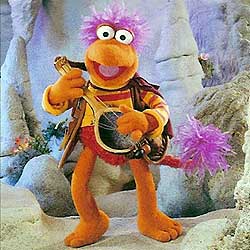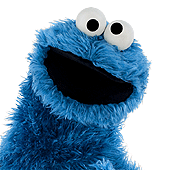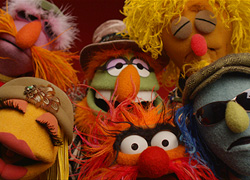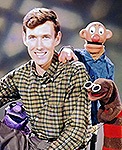I know it always sounds like a cop out but the best thing you can do is practice practice and practice some more.
There was a recent interview with David Goelz in which he said when he first started out his arm used to ache from holding the puppet up. I found a similar thing, along with problems with my tendons tightening to a point I could hardly move my hand at all for about half an hour. After a few months this all eased and now I don't have a problem with that part of it (which was mainly causing sync problems and the puppet kept dipping out of shot.
Also for the lip sync, think of how your mouth moves. If you look at Kermit and co, there are times when the mouth isn't exactly in sync, but if you can capture the main open and closed movements then you are half way there. think about your own mouth saying the words and sync your hand to open and close in time with that. Slow it down if it helps until you have had a bit more practice time. do it in a mirror with just you and your hand. If you think of the numbers one to ten, there is only really seven that is different as it has two syllables. Sometimes it is as much about subtly moving the puppet's head or hand or body to distract from the fact it can only open and close its mouth and cannot move its lips (unless animatronic obviously). Again, referencing Kermit, there aren't many times when you see his head completely still and just opening and closing his mouth. His head is moving, his neck is moving. See what you can do to give your puppet natural movement. again, look at yourself talking - record yourself if you can stand it - and watch how your head moves while you talk.
for the other things like focus, again it is practise. Make sure your puppets eyes are focussed when looking directly forward, then try the technique of standing in front of a mirror and have the puppet look at certain points. Or do it with a person. Have the puppet follow them around the room and get them to tell you if you are with them or not. If you can get it right that way, then with a screen should become simple.
I think the trickiest part of the screen use is that you need to remember that it is like looking at a mirror image of what is going on over your head, which is why I found the mirror use very helpful.
Hope some of that helps.

 Welcome to the Muppet Central Forum!
Welcome to the Muppet Central Forum! Back to the Rock Season 2
Back to the Rock Season 2 Sesame Street Season 54
Sesame Street Season 54 The Muppets Mayhem premieres
The Muppets Mayhem premieres Bear arrives on Disney+
Bear arrives on Disney+ Sam and Friends Book
Sam and Friends Book